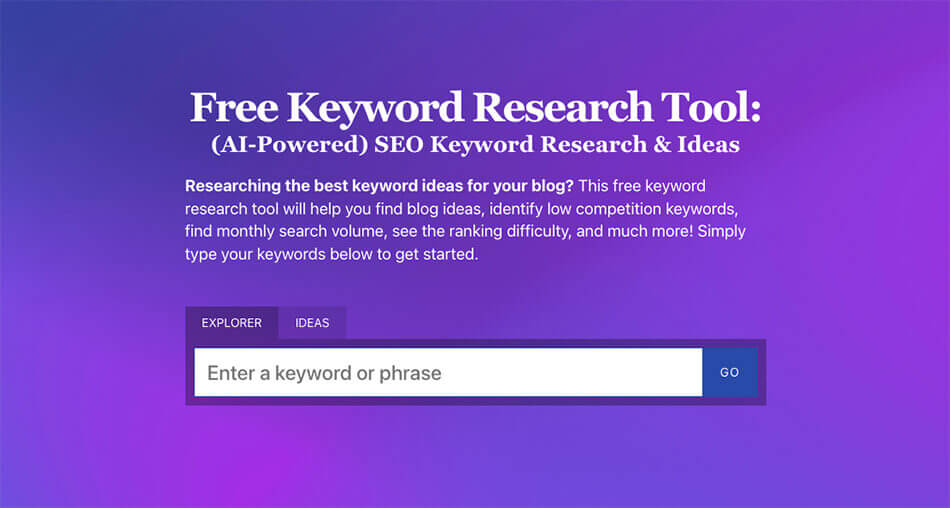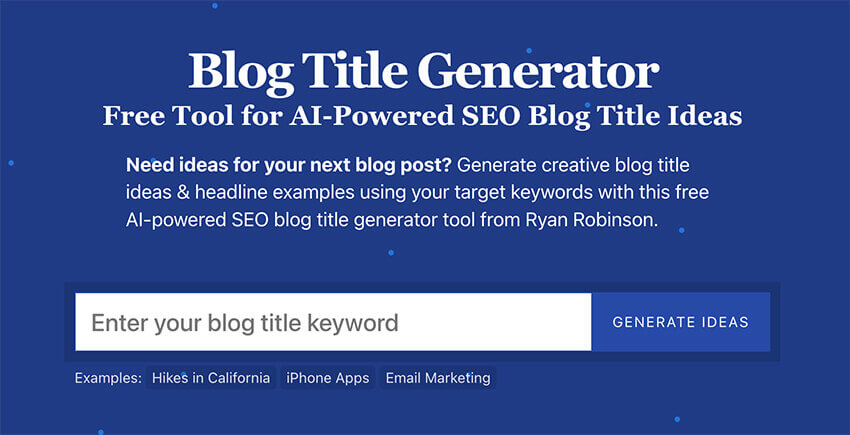Like it or not, evergreen content needs to be in your publishing arsenal if you hope to start a blog that can bring in a steady flow of readers over substantial periods of time.
When you’re building traffic to your blog, you might think it’s best to focus on posts that will bring in traffic right now. Content that jumps on a bandwagon, that gives your take on recent developments in your blog’s niche, or even articles that break a relevant news story in your industry.
But the reality is that those posts won’t bring sustained traffic over time.
As your blog grows, the majority of your traffic will come from posts you wrote months—or even years ago. This is evergreen content: blog content that stays relevant for a long time to come.
We’re going to dig into what evergreen content is (and what it isn’t). Then, we’re going to take a look at how best to create evergreen content that’ll stand the test of time.
What is Evergreen Content: A Blogger’s Guide to Creating Long-Lasting Content
- What Evergreen Content is (and isn’t)
- Why Every Blog Needs Evergreen Content
- Six Tips for Creating Long-Lasting Evergreen Content
- Seven Types of Evergreen Content Ideas to Experiment With
- Getting Your Content Mix Right
Disclosure: Please note that some of the links below are affiliate links and at no additional cost to you, I’ll earn a commission. Know that I only recommend products and services I’ve personally used and stand behind. When you use one of my affiliate links, the company compensates me, which helps me run this blog and keep my in-depth content free of charge for readers (like you).
Now, let’s dive right in.
1. What Evergreen Content is (and isn’t)
Evergreen content is content that stays relevant long after it’s published. Evergreen means it flourishes all year round, year after year, like an evergreen tree.
Evergreen content includes things like:
- How-to posts (so long as the method or tool won’t quickly become dated)
- Lists of tips or ideas on long-lasting topics
- Product reviews (if the product won’t quickly change)
Note: Evergreen content often still needs updating from time to time, particularly if you’re in a fast-moving niche. For instance, you might do a quick refresh of a post every year to make sure all the information is still up-to-date and the links in your post are all working.
Timely (non-evergreen) content includes things like:
- News articles about a recent development or change in an industry
- Posts about a new product release, whether that’s your own product or someone else’s
- Articles focused on a current trend, TV show, or anything else that’s likely to be over soon
- Seasonal articles, like Valentines or Christmas gift ideas (though you could view these as semi-evergreen as they may get traffic for a few weeks each year)
We’ll go over some specific examples of evergreen content (and ideas for inspiration) later on in this guide—but first, let’s take a look at why evergreen content matters so much.
2. Why Every Blog Needs Evergreen Content
Evergreen content is hugely valuable, even if you run a blog that’s normally about breaking news or emerging trends in your industry. If you’re in the business of creating content—no matter how you monetize your blog, at least a portion of your time needs to be allocated to creating evergreen pieces that aim for attracting a consistent flow of readers to your site.
Evergreen content gives you lots of benefits like:
- Sustained long-tail traffic that grows over time: A post you wrote two years ago might bring in more traffic today than when you published it (ideally it will), as more and more bloggers link to your post from their own sites—and as you of course work to promote your blog posts, yourself too.
- Better domain authority (and higher search engine rankings): The more evergreen content you have, the more links your website is likely to attract. This makes your site more trustworthy in the eyes of major search engines like Google. Updating your content over time can also help it rank higher in organic search.
- Content that keeps working for you for years to come: If you’re going to spend several hours creating a great blog post, you want that post to keep bringing in leads and/or affiliate revenue over the long term.
Some blogging niches are an especially good fit for evergreen content. Topics like weight loss, nutrition, parenting, money management, self-improvement and career advice are all ones that will be popular for decades to come.
And while individual tactics might change slightly in terms of what’s working best at any particular moment of time, the core strategies in these areas will remain the same—making these excellent evergreen niches.
3. Six Tips for Creating Long-Lasting Evergreen Content
Now, we’re going to walk through my own personal process for creating content that’s built to stand the test of time. To write great evergreen content, you need to:
1. Do Your Keyword Research
The power of evergreen content lies in its ability to rank consistently well over time in search engines. To take advantage of this, you need to do your keyword research. Choose a suitable keyword to target for your article—one that enough people are searching for (but not one that’s so popular you’ll never be able to rank for it, given where your site’s domain authority is at).
Use My Free Keyword Research Tool
Try my free AI-Powered Keyword Tool to get dozens of research-backed ideas for keywords & topics to write about on your blog today.
2. Optimize Your Post for Your Target Keyword
Your evergreen post should be optimized for your target keyword. There’s not much point in researching the perfect keyword if you fail to use it in your title, for instance. Make sure you’re using your keyword in key areas, like your SEO title, your URL and your meta description.
3. Create Comprehensive Content
It’s well worth investing extra time into writing your evergreen content. You want it to be as complete as possible. That doesn’t necessarily mean it should be super long—some topics can be covered perfectly well in 1,000 words—but it should feel complete and comprehensive.
4. Write for Your Target Audience
Always have your target audience in mind as you craft your evergreen content. Think about your ideal customer or client and tailor your post to their needs. Use the language that resonates with them – for instance, if you have an audience of beginners, don’t use lots of insider jargon.
5. Market Your Evergreen Posts
You can’t simply write a great post and hope to get traffic. Instead, you need to be proactive about marketing it. For instance, you might write guest posts and link back to your post, share it on social media, or include quotes from experts (who might then tweet about your post). Check out these ideas on how to drive traffic for plenty more options.
6. Update Your Evergreen Content Regularly
Even evergreen content needs updating from time to time. Ideally, you should revisit each key piece of evergreen content at least once a year. You might find that your post has broken links, outdated statistics, or typos that you need to fix. You’ll likely also want to add in links to newer posts and any products or services that you’ve created since writing the post.
4. Seven Types of Evergreen Content Ideas to Experiment With
There are plenty of different blog post templates you can use to create evergreen content.
If you’re looking for some evergreen content ideas though, here are some great types of evergreen content to experiment with on your blog—plus real world (successful) examples to learn from.
1. Beginner’s Guide
A beginner’s guide is a great type of evergreen content, as it’s likely to attract readers who are just getting started in your niche. These could then become consistent readers (and customers).
To create a good beginner’s guide, you’ll want to:
- Think like a beginner: What was confusing when you were new to your niche? What terms or acronyms were you unfamiliar with? Make sure you explain things as clearly as possible in your content
- Don’t go into too much detail: Explain what beginners need to know to get started, but don’t give them too much information all at once—instead, include plenty of links to other posts, videos, or resources on your site (as well as to high-quality external resources) for them to continue their learning journey at their own pace
Example: How to Make A Website in 3 Easy Steps: Free Tutorial for Beginners
2. Ultimate Guide
An ultimate guide is a more in-depth piece of content, usually aimed at people who have some experience of your niche. It aims to deliver a full, comprehensive set of instructions on how to accomplish something.
To create a good ultimate guide, you’ll want to:
- Break your guide into clear sections: If your post is very long, you might even split these across multiple pages on your site
- Include a summary at the start, with links to each section: You could also consider including an infographic or other visual summary of the piece
- Take care to explore every important detail (anticipate and answer questions): If you’re walking through a complex tutorial (like how to migrate from WordPress.com to WordPress.org), it pays dividends for your ultimate guide to be very comprehensive by anticipating and answering key questions your readers will have as they make their way through your content
Example: 10 Steps to Starting a Side Business: Infographic & How-To Guide
3. X Best Tools
Listing the best tools for a particular task makes for a great evergreen post. It may need a little more updating than some other types of posts, but you can easily switch tools around or add new ones as time goes by.
To create a good “best tools” post, you’ll want to:
- Explain the pros and cons of each tool: Readers want your honest opinion and a clear idea of which tool will best suit their specific needs
- Use affiliate links: This type of post can bring in a lot of affiliate revenue over time, so make the most of that by ensuring you use affiliate links where possible
Example: 9 Best Website Builders for Bloggers and Business Owners (Easy to Use) This Year
4. X Best Books
Like the X Best Tools post, a list of the best books relating to a particular topic in your niche (or even your niche as a whole) can become a great source of traffic and affiliate income.
To create a good “best books” post, you’ll want to:
- Notify each book’s author (if they have an online presence): They might well be thrilled to share your post with their audience—giving it a useful initial boost of traffic and attention
- Summarize what you love about the book: Don’t just list the books, explain the key point each book makes or the benefit of reading it
Example: 85 Best Business Books for Entrepreneurs, Creatives and Professionals to Read This Year
5. Checklist
Checklists are hugely popular. They’re the type of content that readers may return to again and again, too, making them a great way to nurture prospects and turn them into customers.
To create a good checklist, you’ll want to:
- Choose the right topic: Pick something that has lots of steps that can be easily listed and that readers will want to repeat again and again—like “editing a blog post” or “Christmas planning”
- Consider turning your checklist into a graphic: The goal of this tactic is so that it can be easily shared on social media, or even embedded in other people’s blog posts (thus linking back to yours)
As a quick aside, if you’re having trouble with your content planning efforts, you can grab my free blog planner bundle and turn things up a notch today.
Example: Slidebean’s checklist of “What should be on your pitch deck?” included in 18 Pitching Essentials: How to Pitch an Idea to Investors (and Early Customers)
6. Case Study
A case study lets you show the results you got for a client or that someone achieved using your product. You can even do a case study on something you achieved yourself, as a “How I…” post.
To create a good case study, you’ll want to:
- Include figures: How much did traffic increase by? What was the client’s ROI? Readers will love to see hard numbers, especially when those relate to money
- Give details about exactly how the client (or you) achieved the results: You may also want to offer the reader some simple steps for getting started with something similar
Example: My own blog income reports
7. Top Tips
A post of top tips on a key topic can make for a solid piece of evergreen content. Think about topics that will be popular for years to come. For instance, you might write a list of tips for “dealing with your toddler’s temper tantrums” or “writing email headlines that get attention.”
To create a good top tips post, you’ll want to:
- Format your post clearly: Make sure each tip has its own section and (especially if you have lots of tips) consider having a straightforward summary at the top, with a link to each tip
- Go beyond the basics: It’s easy to offer simple, tried-and-true tips in a list post—and while those are valuable, it’s even better if you can go further and give more unusual or more advanced tips
Example: How to Write a Headline That Captures Attention (26 Blog Headline Writing Tips)
Need Catchy Blog Title Ideas?
Try my free AI-Powered Blog Title Generator Tool to get dozens of SEO-friendly headline ideas to make your blog posts stand out today.
5. Getting Your Content Mix Right
Most blogs will (and should) have a healthy mix of evergreen content and timely content. That being said, it’s important to find the right balance for your blog.
For instance, if you share daily content to keep readers up-to-date with the latest developments in your niche, then much of your content will be timely—but you’ll still want some evergreen pieces to help you build long-term traffic and diversify away from the need to publish every single day.
Do you already have some evergreen content on your blog?
This week, take a look through your existing posts to see if you can update and improve one to make it an even better piece of long-lasting content.
You may even see a nice lift in traffic after your next update 😊
If you’re just getting going on your blogging journey (or if you’re launching a new site), then make sure you check out my guide to get up and running fast.
Want to Start Your Blog (the Right Way)?
Check out my ultimate guide How to Start a Blog (on the Side).








Thanks for the tips and information. I really appreciate it..
You’re very welcome, Anna! 🙏
Nice blog to read, thanks Ryan.
You’re very welcome! 🙏
Hi Ryan,
I agree with you that every blogger and content marketers should create evergreen content since they last the longest and drive regular traffic. Your guide is timely, especially since the competition for attention is intense. So, following your tips on creating evergreen content can make all the difference in gaining more visibility on SERPs. Besides, it would be best to produce blog articles around topics that qualify for evergreen content. That way, you guarantee consistent organic traffic because more online readers are busy searching for such blog posts.
Thanks for sharing!
Absolutely! I couldn’t agree more… the competition for attention is a trend that’ll only continue picking up pace, so it’ll pay dividends to find ways you can stand out from the crows on evergreen topics that’ll continue delivering new readers your way for the months & years to come 🙏
Amazing post Ryan i just started my blog one year ago and I have been thinking about adding more evergreen content to my blog,
I love blogging at the same time after we cover the basics that’s when it becomes more difficult in deciding what to post so my visitors and subscribers can get the most out of it.
Thanks, Alex! I definitely say go for it, when it comes to thinking about pursuing more evergreen content topics… it’s hard to go wrong with that as at least a part of your strategy. If you’re coming up short on ideas for what to write about sometimes, I’d always recommend starting by polling your readers—what questions do they have, that you can answer? This guide of mine with 200+ blog post ideas might spark some inspiration too 🙂 https://www.ryrob.com/blog-post-ideas/
Hi Ryan
I am your regular reader and I just loved your content. Hope to meet you once 😊
I appreciate you, Sanu! Thanks for leaving a comment—and if you’re ever in Los Angeles, definitely let me know… coffee or lunch on me 🙂
Hi, Ryan
i am ck from Gujarat, India.
i read your blog every time you published new article and monthly report.
Love to hear that, Chetan. Thanks for following along! 🙂
Hi Dear Ryan
Your blog was valuable. Thank you.
Sathya Narayana B
You’re welcome, Sathya! 🙏
Thanks Ryan for this post. I’ve just realized this is what I’ve been doing without knowing the phrase ‘evergreen content’.
You’re welcome! Now that’s a happy coincidence 🙂 good luck!
Hi Ryan,
Sometimes it isn’t just coincidence! I subscribed to your email newsletters earlier this year, and I’m proud to say that it was worth it.
Many thanks, keep giving us the good and informative content.
(Can I email you? I need some guidance please)
Love hearing that, thanks for following along with me this year! Absolutely, shoot me an email anytime—I’m ryan@ryrob.com
Thanks for the wonderful info. Writing content optimized for search and conversion is an art.
You’re welcome, Robi!
thanks you for sharing beautiful article it helps a lot in generating traffic in my new blog